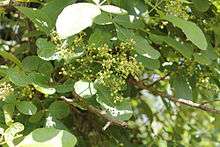Toxicodendron parviflorum
| Toxicodendron parviflorum | |
|---|---|
 | |
| Scientific classification | |
| Kingdom: | Plantae |
| (unranked): | Angiosperms |
| (unranked): | Eudicots |
| (unranked): | Rosids |
| Order: | Sapindales |
| Family: | Anacardiaceae |
| Genus: | Toxicodendron |
| Species: | T. parviflorum |
| Binomial name | |
| Toxicodendron parviflorum Kuntze | |

Toxicodendron parviflorum fruit
Toxicodendron parviflorum commonly known as small-flowered poison sumac is a much-branched shrub bearing stalked leaves with three leaflets; the end leaflet is larger than the other two. The leaflets are obovate, with rounded tips, tapering bases and irregularly toothed margins. The flowers are tiny, yellowish and fragrant. The fruit is small, round and red when ripe. T. parviflorum is found in the Himalayas, from Kumaun to Bhutan, at altitudes of 700–1,100 metres (2,300–3,600 ft).[1]
References
This article is issued from Wikipedia - version of the 9/14/2016. The text is available under the Creative Commons Attribution/Share Alike but additional terms may apply for the media files.